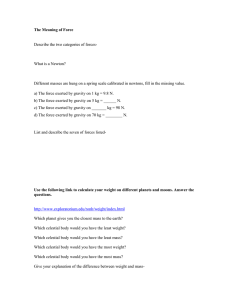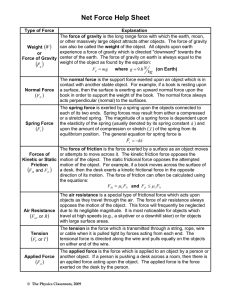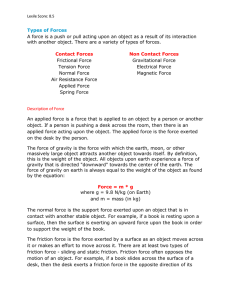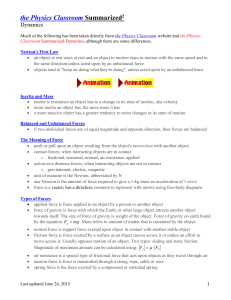Forces and Freebody Diagrams
advertisement
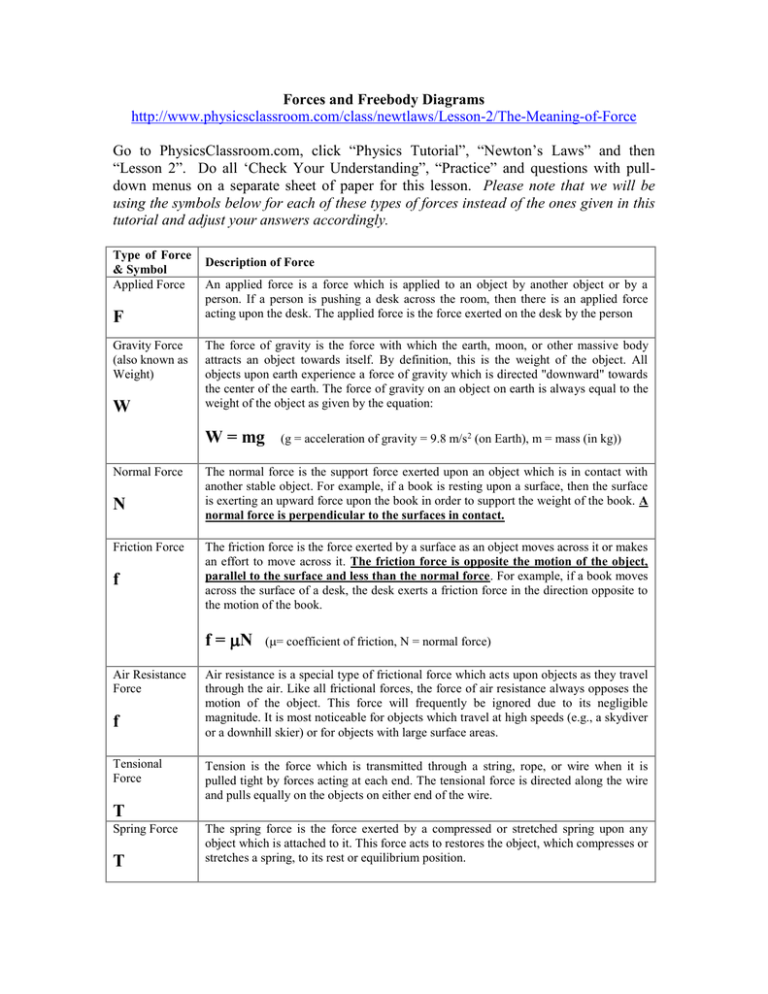
Forces and Freebody Diagrams http://www.physicsclassroom.com/class/newtlaws/Lesson-2/The-Meaning-of-Force Go to PhysicsClassroom.com, click “Physics Tutorial”, “Newton’s Laws” and then “Lesson 2”. Do all ‘Check Your Understanding”, “Practice” and questions with pulldown menus on a separate sheet of paper for this lesson. Please note that we will be using the symbols below for each of these types of forces instead of the ones given in this tutorial and adjust your answers accordingly. Type of Force & Symbol Applied Force F Gravity Force (also known as Weight) W Description of Force An applied force is a force which is applied to an object by another object or by a person. If a person is pushing a desk across the room, then there is an applied force acting upon the desk. The applied force is the force exerted on the desk by the person The force of gravity is the force with which the earth, moon, or other massive body attracts an object towards itself. By definition, this is the weight of the object. All objects upon earth experience a force of gravity which is directed "downward" towards the center of the earth. The force of gravity on an object on earth is always equal to the weight of the object as given by the equation: W = mg Normal Force N Friction Force f The normal force is the support force exerted upon an object which is in contact with another stable object. For example, if a book is resting upon a surface, then the surface is exerting an upward force upon the book in order to support the weight of the book. A normal force is perpendicular to the surfaces in contact. The friction force is the force exerted by a surface as an object moves across it or makes an effort to move across it. The friction force is opposite the motion of the object, parallel to the surface and less than the normal force. For example, if a book moves across the surface of a desk, the desk exerts a friction force in the direction opposite to the motion of the book. f = N Air Resistance Force f Tensional Force (g = acceleration of gravity = 9.8 m/s2 (on Earth), m = mass (in kg)) (= coefficient of friction, N = normal force) Air resistance is a special type of frictional force which acts upon objects as they travel through the air. Like all frictional forces, the force of air resistance always opposes the motion of the object. This force will frequently be ignored due to its negligible magnitude. It is most noticeable for objects which travel at high speeds (e.g., a skydiver or a downhill skier) or for objects with large surface areas. Tension is the force which is transmitted through a string, rope, or wire when it is pulled tight by forces acting at each end. The tensional force is directed along the wire and pulls equally on the objects on either end of the wire. T Spring Force T The spring force is the force exerted by a compressed or stretched spring upon any object which is attached to it. This force acts to restores the object, which compresses or stretches a spring, to its rest or equilibrium position. Check Your Understanding http://www.physicsclassroom.com/class/newtlaws/Lesson-2/Types-of-Forces 1. Complete the following table showing the relationship between mass and weight. Object Melon Mass (kg) Weight (N) 1 kg Apple 0.98 N Pat Eatladee 25 kg Fred See Answer 980 N 2. Different masses are hung on a spring scale calibrated in Newtons. a. b. c. d. The force exerted by gravity on 1 kg = 9.8 N. The force exerted by gravity on 5 kg = ______ N. The force exerted by gravity on _______ kg = 98 N. The force exerted by gravity on 70 kg = ________ N. 3. When a person diets, is their goal to lose mass or to lose weight? Explain. Practice http://www.physicsclassroom.com/class/newtlaws/Lesson-2/Drawing-Free-Body-Diagrams Apply the method described in the paragraph above to construct free-body diagrams for the various situations described below. 1. 2. A book is at rest on a tabletop. Diagram the forces acting on the book. A girl is suspended motionless from the ceiling by two ropes. Diagram the forces acting on the combination of girl and bar. 3. An egg is free-falling from a nest in a tree. Neglect air resistance. Diagram the forces acting on the egg as it is falling. 4. A flying squirrel is gliding (no wing flaps) from a tree to the ground at constant velocity. Consider air resistance. Diagram the forces acting on the squirrel. 5. A rightward force is applied to a book in order to move it across a desk with a rightward acceleration. Consider frictional forces. Neglect air resistance. Diagram the forces acting on the book. 6. A rightward force is applied to a book in order to move it across a desk at constant velocity. Consider frictional forces. Neglect air resistance. Diagram the forces acting on the book. 7. A college student rests a backpack upon his shoulder. The pack is suspended motionless by one strap from one shoulder. Diagram the vertical forces acting on the backpack. 8. A skydiver is descending with a constant velocity. Consider air resistance. Diagram the forces acting upon the skydiver. 9. A force is applied to the right to drag a sled across loosely packed snow with a rightward acceleration. Diagram the forces acting upon the sled. 10. A football is moving upwards towards its peak after having been booted by the punter. Diagram the forces acting upon the football as it rises upward towards its peak. 11. A car is coasting to the right and slowing down. Diagram the forces acting upon the car. Check Your Understanding http://www.physicsclassroom.com/class/newtlaws/Lesson-2/Determining-the-Net-Force 1. Free-body diagrams for four situations are shown below. For each situation, determine the net force acting upon the object. is known for each situation. However, the magnitudes of a few of the individual forces are not known. Analyze each situation individually and determine the magnitude of the unknown forces. Then click the button to view the answers.
